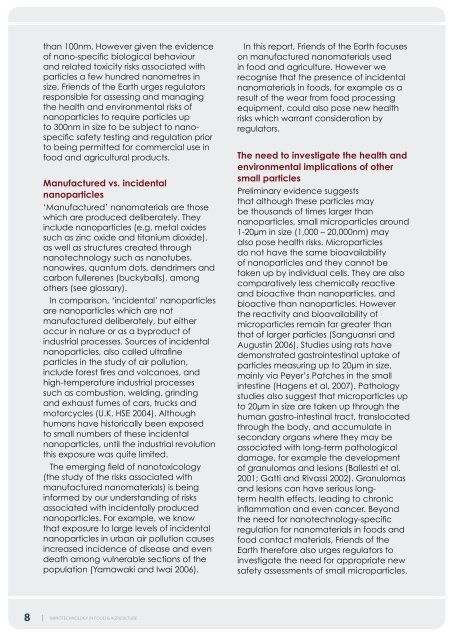Nanotechnology in Food & Agriculture - denix
Nanotechnology in Food & Agriculture - denix
Nanotechnology in Food & Agriculture - denix
Create successful ePaper yourself
Turn your PDF publications into a flip-book with our unique Google optimized e-Paper software.
8<br />
than 100nm. However given the evidence<br />
of nano-specific biological behaviour<br />
and related toxicity risks associated with<br />
particles a few hundred nanometres <strong>in</strong><br />
size, Friends of the Earth urges regulators<br />
responsible for assess<strong>in</strong>g and manag<strong>in</strong>g<br />
the health and environmental risks of<br />
nanoparticles to require particles up<br />
to 300nm <strong>in</strong> size to be subject to nanospecific<br />
safety test<strong>in</strong>g and regulation prior<br />
to be<strong>in</strong>g permitted for commercial use <strong>in</strong><br />
food and agricultural products.<br />
Manufactured vs. <strong>in</strong>cidental<br />
nanoparticles<br />
‘Manufactured’ nanomaterials are those<br />
which are produced deliberately. They<br />
<strong>in</strong>clude nanoparticles (e.g. metal oxides<br />
such as z<strong>in</strong>c oxide and titanium dioxide),<br />
as well as structures created through<br />
nanotechnology such as nanotubes,<br />
nanowires, quantum dots, dendrimers and<br />
carbon fullerenes (buckyballs), among<br />
others (see glossary).<br />
In comparison, ‘<strong>in</strong>cidental’ nanoparticles<br />
are nanoparticles which are not<br />
manufactured deliberately, but either<br />
occur <strong>in</strong> nature or as a byproduct of<br />
<strong>in</strong>dustrial processes. Sources of <strong>in</strong>cidental<br />
nanoparticles, also called ultraf<strong>in</strong>e<br />
particles <strong>in</strong> the study of air pollution,<br />
<strong>in</strong>clude forest fires and volcanoes, and<br />
high-temperature <strong>in</strong>dustrial processes<br />
such as combustion, weld<strong>in</strong>g, gr<strong>in</strong>d<strong>in</strong>g<br />
and exhaust fumes of cars, trucks and<br />
motorcycles (U.K. HSE 2004). Although<br />
humans have historically been exposed<br />
to small numbers of these <strong>in</strong>cidental<br />
nanoparticles, until the <strong>in</strong>dustrial revolution<br />
this exposure was quite limited.<br />
The emerg<strong>in</strong>g field of nanotoxicology<br />
(the study of the risks associated with<br />
manufactured nanomaterials) is be<strong>in</strong>g<br />
<strong>in</strong>formed by our understand<strong>in</strong>g of risks<br />
associated with <strong>in</strong>cidentally produced<br />
nanoparticles. For example, we know<br />
that exposure to large levels of <strong>in</strong>cidental<br />
nanoparticles <strong>in</strong> urban air pollution causes<br />
<strong>in</strong>creased <strong>in</strong>cidence of disease and even<br />
death among vulnerable sections of the<br />
population (Yamawaki and Iwai 2006).<br />
| NANOTECHNOLOGY IN FOOD & AGRICULTURE<br />
In this report, Friends of the Earth focuses<br />
on manufactured nanomaterials used<br />
<strong>in</strong> food and agriculture. However we<br />
recognise that the presence of <strong>in</strong>cidental<br />
nanomaterials <strong>in</strong> foods, for example as a<br />
result of the wear from food process<strong>in</strong>g<br />
equipment, could also pose new health<br />
risks which warrant consideration by<br />
regulators.<br />
The need to <strong>in</strong>vestigate the health and<br />
environmental implications of other<br />
small particles<br />
Prelim<strong>in</strong>ary evidence suggests<br />
that although these particles may<br />
be thousands of times larger than<br />
nanoparticles, small microparticles around<br />
1-20µm <strong>in</strong> size (1,000 – 20,000nm) may<br />
also pose health risks. Microparticles<br />
do not have the same bioavailability<br />
of nanoparticles and they cannot be<br />
taken up by <strong>in</strong>dividual cells. They are also<br />
comparatively less chemically reactive<br />
and bioactive than nanoparticles, and<br />
bioactive than nanoparticles. However<br />
the reactivity and bioavailability of<br />
microparticles rema<strong>in</strong> far greater than<br />
that of larger particles (Sanguansri and<br />
August<strong>in</strong> 2006). Studies us<strong>in</strong>g rats have<br />
demonstrated gastro<strong>in</strong>test<strong>in</strong>al uptake of<br />
particles measur<strong>in</strong>g up to 20µm <strong>in</strong> size,<br />
ma<strong>in</strong>ly via Peyer’s Patches <strong>in</strong> the small<br />
<strong>in</strong>test<strong>in</strong>e (Hagens et al. 2007). Pathology<br />
studies also suggest that microparticles up<br />
to 20µm <strong>in</strong> size are taken up through the<br />
human gastro-<strong>in</strong>test<strong>in</strong>al tract, translocated<br />
through the body, and accumulate <strong>in</strong><br />
secondary organs where they may be<br />
associated with long-term pathological<br />
damage, for example the development<br />
of granulomas and lesions (Ballestri et al.<br />
2001; Gatti and Rivassi 2002). Granulomas<br />
and lesions can have serious longterm<br />
health effects, lead<strong>in</strong>g to chronic<br />
<strong>in</strong>flammation and even cancer. Beyond<br />
the need for nanotechnology-specific<br />
regulation for nanomaterials <strong>in</strong> foods and<br />
food contact materials, Friends of the<br />
Earth therefore also urges regulators to<br />
<strong>in</strong>vestigate the need for appropriate new<br />
safety assessments of small microparticles.
















